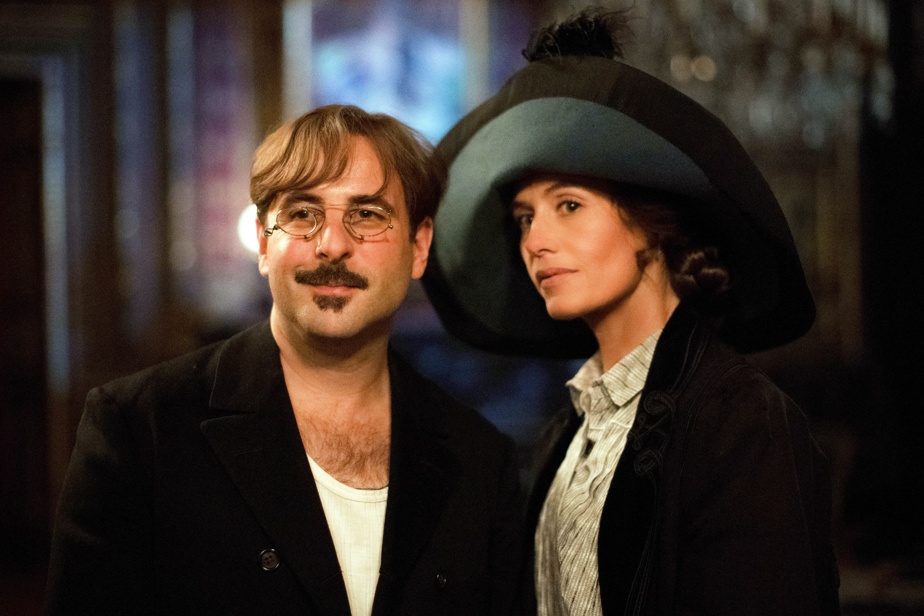If he voluntarily devoted biographical dramas to the painter Séraphine de Senlis (Seraphine2008) and to the author Violette Leduc (Violet, 2013), Martin Provost hesitated when Pierrette Vernon asked him, around fifteen years ago, to make one about his great-aunt Marthe Bonnard. Muse and wife of Pierre Bonnard, a painter affiliated with the Nabi movement, for nearly 50 years, this woman from a modest background who claimed to be an aristocrat and without a family signed some 80 works under the pseudonym Marthe Solange from 1921 to 1926.
“It’s a beautiful, interesting and coherent work, but I couldn’t make a film about Marthe alone,” explains the filmmaker we met in January at the Unifrance Rendez-vous in Paris. There wasn’t enough to tell. I was not overwhelmed by his paintings as I had been by those of Séraphine. I am much more sensitive to the work of Pierre Bonnard. actually, I live in a painting by Bonnard; Every time I’m there, this place puts my feet back on the ground. »

PHOTO MARKUS SCHREIBER, ASSOCIATED PRESS ARCHIVES
Filmmaker Martin Provost in 2017
Confined during the pandemic at his home, 10 kilometers from La Roulotte, a country house where the Bonnards lived for several years on the banks of the Seine, Martin Provost then began to take an interest in the couple.
While leafing through a book, he comes across Lunch, a painting where Marthe appears with a cup in her hand. The filmmaker notices that Bonnard seems to have wanted to erase his wife’s eyes.
“It’s as if the painter was trying to understand who she is, as if Marthe’s lie was in the paintings. Turning the pages of the book, I realized that we never saw Marthe’s face. And even in the photos where they say it’s Marthe Bonnard, it’s not her. Bonnard is a painter that I admire, but I told myself that by making a film about the couple, I would get to the heart of something that corresponds more to me today. I was going to explore something other than just the work of a woman. »
A bright film
To play the Bonnard couple from 1893 to 1942, Martin Provost first called on Vincent Macaigne, with whom he was to shoot a film on another painter. In order for him to look a little more like Pierre Bonnard and approach his elegance and discretion, he simply put the actor on a diet. Then, for the light he saw in her, he set his sights on Cécile de France, who wanted to escape the register of the brave girl. In order to bring the Bonnard world to life, the director enlisted the services of cinematographer Guillaume Schiffman for the first time.

PHOTO PROVIDED BY SPHERE FILMS
Cécile de France and Stacy Martin in Bonnard, Pierre and Martheby Martin Provost
“So I shot the film very close to my home, at the water’s edge, surrounded by landscapes that were painted by Bonnard, by Monet, by Joan Mitchell, by all the painters who lived there. With Guillaume, what we knew about the lighting was that we didn’t want to be in a historical reconstruction – I hate this atrocious word biopic which locks you into the obligation of a filmed documentary. We wanted a film with substance, which was solar and luminous. »
I wanted us to smell the paint. I tried to enter Bonnard’s paintings, to see their field, but I did not think that I was going to recreate paintings.
Martin Provost
Thus he shows Bonnard observing Marthe lying naked on the bed with the sheets undone, which will lead him to create one of his most famous paintings, The indolent. When Marthe asks Pierre why it is women who pose naked and not men, he executes the painting The man and the woman, where both are naked, separated by a screen. Later, when Renée Montchaty (Stacy Martin), a fine arts student, becomes the painter’s mistress, Martin Provost imagines in what circumstances he painted The terrace in Vernonwhere the brunette Marthe and the blonde Renée appear.
The true from the false
Besides Bonnard, the filmmaker also features his wife at work: “It was interesting to show within the film how Marthe had this desire for emancipation, this desire for survival. She started painting when Bonnard left with Renée for Italy. In her paintings and pastels, she expresses her suffering by returning to something of innocence, of childhood. It’s touching to see that she stopped everything when she found Pierre. It was not her goal to be a painter, her goal was to be the painter’s companion. »
Obviously, this is the interpretation of Martin Provost, who was able to count on the support of Françoise Cloarec, author of the book The indolent: the mystery of Marthe Bonnardto write the screenplay for Bonnard, Pierre and Marthe with his faithful collaborator Marc Abdelnour. According to the filmmaker, the liberties he took with history, such as the disappearance of Renée and the painting found in Rome, were true.
“It’s where art meets science or whatever we’re missing. I believe enough in these worlds; in any case, each time I make a film, I notice that I capture things which are undoubtedly in the collective unconscious or in the invisible and which are not so false, since I am later taught that They are true. Maybe my interpretation adds something to the real story. »
Indoors
Travel expenses were paid by Unifrance.
